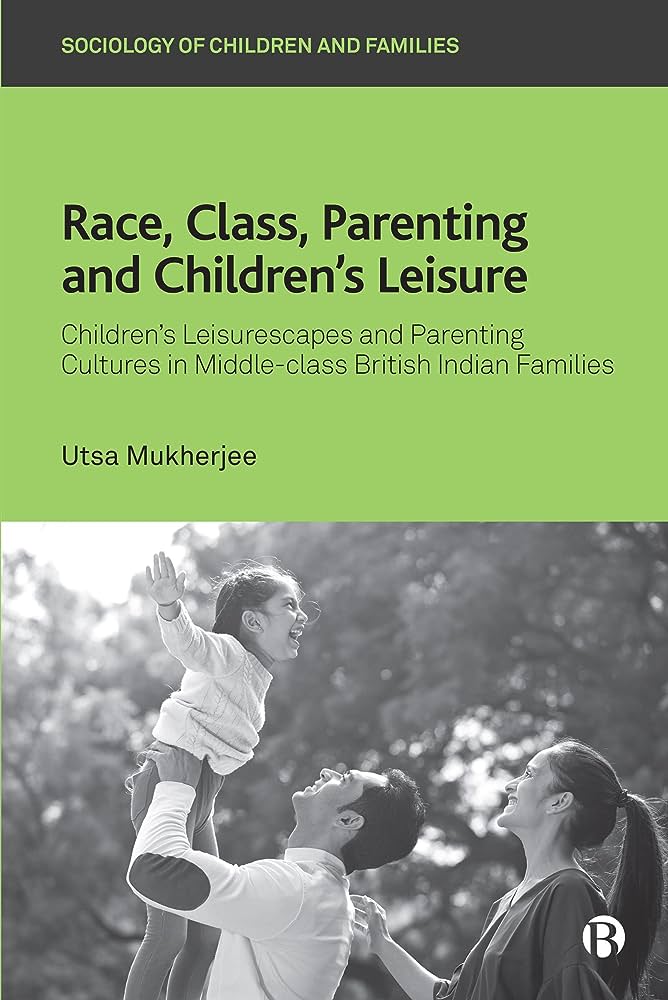
Utsa Mukherjee’s Race, Class, Parenting and Children’s Leisure: Children’s Leisurescapes and Parenting Cultures in Middle-class British Indian Families (published by Bristol University Press in 2023) explicates the lives of professional middle-class British Indians in terms of the unique position they occupy in the UK’s social class and racial hierarchies. It implores how such intersectionality that simultaneously privileges and excludes them shapes both the children’s leisure and leisure-based parenting strategies. It further looks at the role of leisure in the performance and reproduction of class privileges across generations as well as in nurturing diasporic cultural identities and a sense of belonging to the Indian cultural heritage. The author argues how British Indians are not caught ‘between two cultures’ but sees them as ‘adroit cultural actors’ who embody cultural resources quite flexibly, in turn granting them access to and acceptance in majorly white British society (p.3).
The book is based on interviews with professional middle-class British Indian parents in London and its commuter belt, who on the one hand enjoy relative economic privilege and wealth, and on the other hand, occupy a position of relative racial disadvantage as minority ethnic subjects. They include a mix of Indian-born and non-Indian-born diaspora; homeowners, university degree-holders occupying higher ranks within different sectors like IT, software, finance, medicine, and education; and who come from different linguistic and religious backgrounds. The qualitative study includes 10 families and is based on semi-structured interviews, along with ethnographic observation at homes, community functions and online spaces. The author has also interviewed children and conducted participatory drawing activities with them to hear their perspectives on their leisure engagements. The book tries to fill in the gaps in the existing literature where the research has majorly adopted a race-blind approach to studying middle-class parenting and leisure, in contemporary Britain; failing therefore to account for how class and racial inequalities intersect.
Taking feminist and anti-racist perspectives on leisure, the book debunks the understanding of the British Asian children as ‘caught between two cultures’ or binaries of individualism/collectivism, also moving past the understanding of children as merely following the tunes of their parents. Instead, never really losing sight of the lived realities of children it reifies them as agentic beings. It lays bare the ways leisure shapes the everyday geographies of racialized middle-class children; and the way they make sense of the various kinds of leisure activities that they take part in. Foregrounding race and class it maps children’s leisure, offering fresh insights into children’s intra and intergenerational relationships and their agency. It further departs from the former approach of theorising children’s agency anchored in neoliberal ideas of individualism that view children as ‘independent social actors’. Rather it builds upon the relational model of child agency, it conceives of children’s agency as heterogeneous-that disperses across the whole range of relationships that children are a part of with other humans, materials or nonhuman actors.
The book offers a sustained dialogue between leisure studies and childhood studies, proposes a critical sociological framework for unpacking children’s leisure; and offers a tripartite model of three interlocking genres of children’s leisure-namely organised, family and casual leisure. It further applies a temporal perspective to the leisurescape of children where with all the scheduling and time management, leisure apart from sometimes holding a utilitarian value and other times exemplifying diasporas consciousness and cultural identity; also emerges as a way of looking out for each other, ‘doing family’ and memory making. And, in all three genres, while parents determine the kind of activities or the time allotted to each activity that comprises leisure, children also navigate and negotiate many choices.
The book manages to capture leisure as an inter-subjective and negotiated temporal experience against the understanding of leisure as an individual residual experience or free time beyond the paid work/housework. It shows how leisure is entangled with spatial, generational and material contexts; also extending beyond individual and family experiences to forge inter-community social ties and place-making in the urban multiethnic landscape of Britain. On one hand, where the book underscores how practices like the public celebration of festivals like Diwali are both pedagogical that enhance the diaspora community’s city-making practices, on the other hand, it also depicts how such practices also reproduce and universalise the upper caste, middle class, north/western perspectives as Indian heritage and culture.
It is a well-written book that flows lucidly without the use of jargon. It is ethnographically rich and the discussion on the author’s positionality vis-a-vis the field also makes it a refreshing read. It shall benefit researchers in the field of Sociology of Childhoods, Sociology of Leisure and Sociology of Families.
***
Aatina Nasir Malik teaches in the Department of Sociology, Indraprastha College for Women (IPCW), University of Delhi, New Delhi. She has a PhD in Sociology from the Indian Institute of Technology (IIT) Delhi.